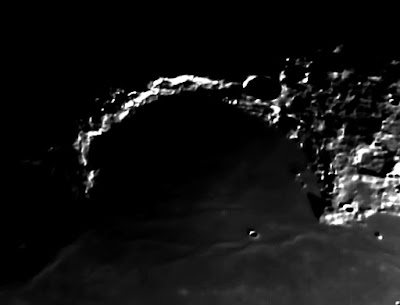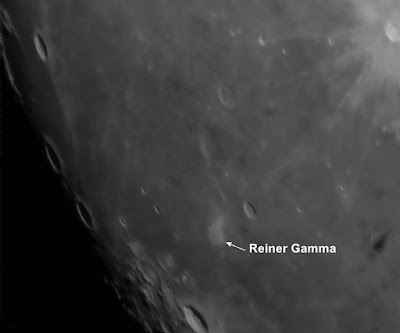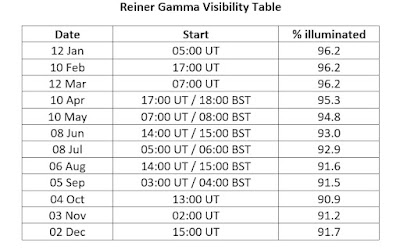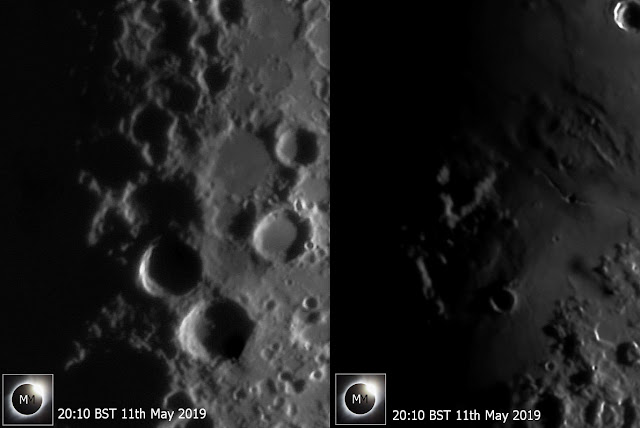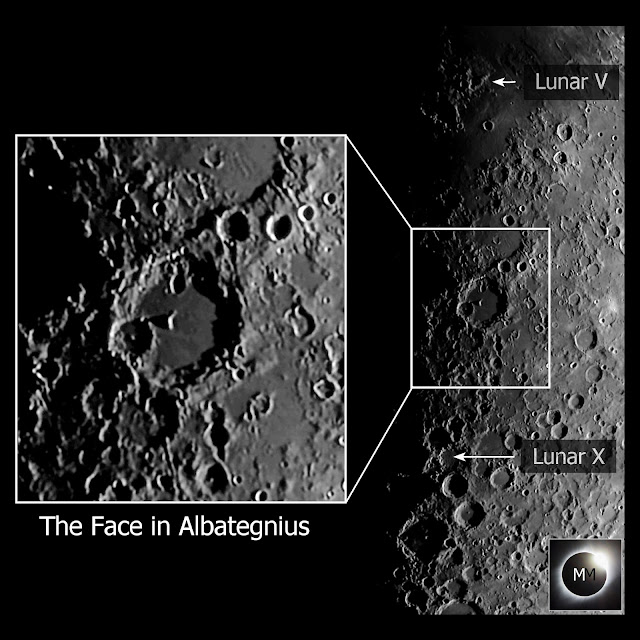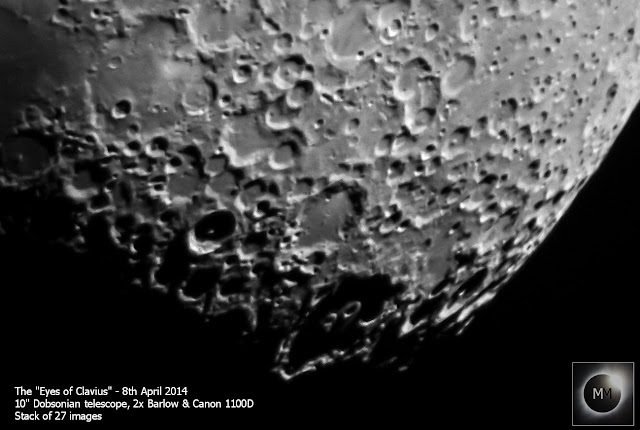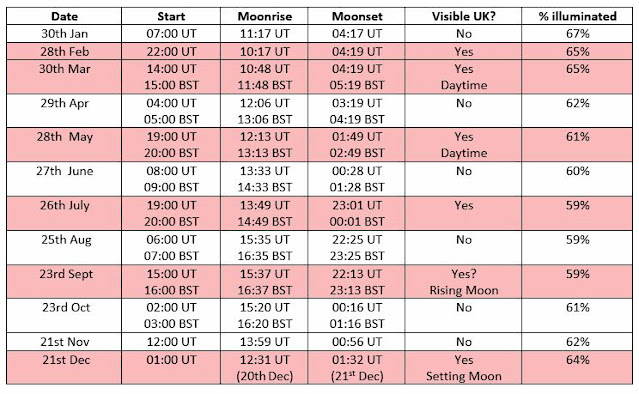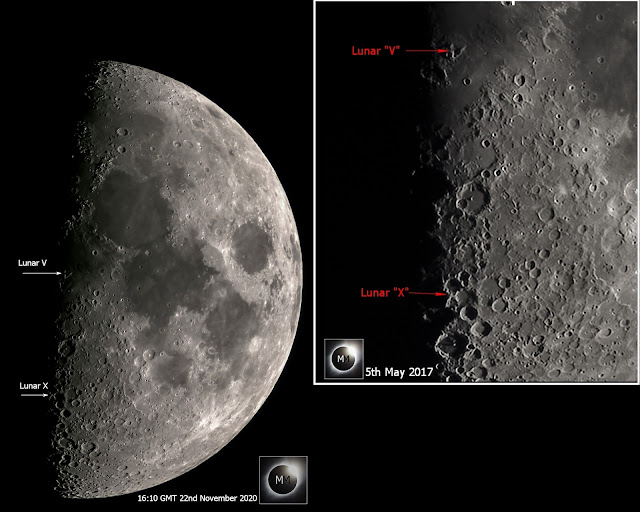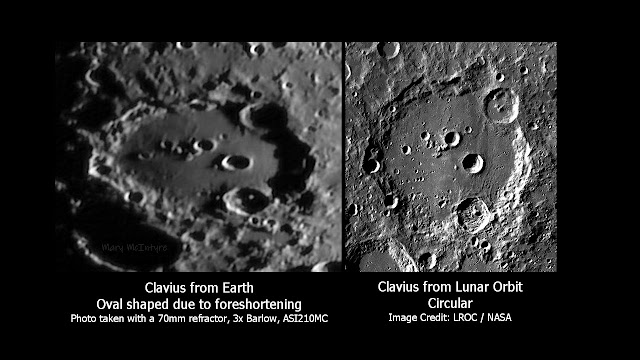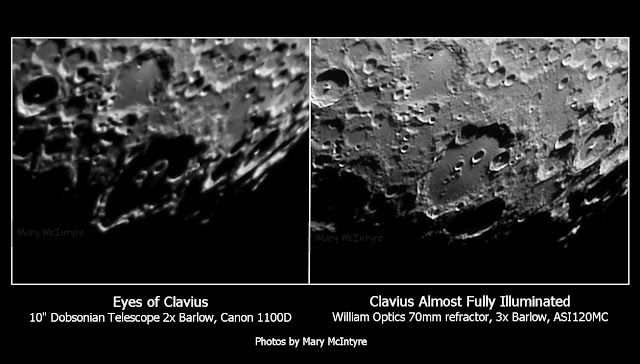Popular
Clair-Obscur Effects: Times for 2025
Lunar X & V, the Face in Albategnius, the Eyes of Clavius, the Jewelled
Handle, Cassini’s Moon Maiden and Reiner Gamma
by Mary McIntyre
**Accessibility note: because of limitations in the blog software, the data tables in this blog have had to be added as photographs so the text will not be accessible to screen readers. However, the text in the PDF download will be fully accessible and you can access that here:
https://marymcintyreastronomy.co.uk/wp-content/uploads/sites/2/2025/01/Lunar-X-and-other-Clair-Obscur-Times-for-2025.pdf
Watch my accompanying You Tube video here:
https://youtu.be/zsBXlunvSjc
With the exception of Cassini's Moon Maiden drawing on his lunar map and the LRO image of Clavius, all photographs and pastel drawings in this blog are my own.
You are free to use them as long as you credit them to Mary McIntyre.
___________________________________________
For the past few years I have produced a table showing the
times that the Lunar X and V are visible for the coming year. I know these are the most popular of the
Clair-Obscur effects but they are not the only ones, so a couple of years ago I
added the Face in Albategnius, the Eyes of Clavius, the Jewelled Handle AKA
Sinus Iridum, Cassini’s Moon Maiden AKA Promontorium Heraclides. This year I’ve
an additional feature to look for and that is the lunar swirl Reiner Gamma. Although
Reiner Gamma is not actually a clair obscur effect, its appearance is related
to the way the light plays over the lunar surface. More about this at the end!
The full list of times in UT for these features being visible
can be found in the tables below but firstly, for those of us in the UK I’ve collated
everything into one quick reference table so you can see month by month if a
feature is visible or not. I hope this simplifies things a bit and hopefully
this will give you something new to tick off your lunar observing list. More detailed
information about each of these effects is below, but for those of you who are
only interested in the data tables, I’ve put those first.
Quick Check Visibility Table for UK Observers
The Lunar X and V
Lunar X and V Visibility Table
The Face in Albategnius
Approximately 6 hours after the Lunar X is at its best, when the terminator has moved across to cover the area around it, take a close look at the shadows on the right hand side of the crater Albategnius (located almost halfway between the X and V). At just the right time the shadow looks like the side profile of a face. This shows up more clearly on stacked photos which have better resolution and sharper features. The above image was taken with a William Optics 70mm refractor with Celestron 3x Barlow. The camera was an ASI120MC. This is another short-lived Clair-Obscur effect, so make sure you don’t miss it! The approximate times are in the collated table at the beginning of the blog.
The Eyes of Clavius
The Eyes of Clavius Visibility Table
This clair-obscur effect is best viewed at the start time
below but remains visible after the lunar terminator has passed over the region
so it should therefore be visible for a large part the dates listed below.
The Jewelled Handle Visibility Table
Cassini’s Moon Maiden
Cassini’s Moon Maiden starts to become visible and is at its
best as the Sun rises over Sinus Iridum and illuminates Promontorium Heraclides,
then remains visible for a couple of days. The times below are just a guide.
Cassini’s Moon Maiden Visibility Table
Reiner Gamma
Reiner Gamma is a prominent lunar swirl that I think resembles a tadpole!
Reiner Gamma Visibility Table
Additional information
if you’re new to these effects
The times given in the data tables are in 24 hour clock and
are in UT/GMT (and BST where appropriate) so you will need to correct for time
zones and daylight time savings if you are not in the UK. I have also included
the approximate moonrise and moonset times in the tables for the effects that
are time critical. These times were taken from the Time and Date website and
relate to London, UK. Your exact rise and set times will vary
depending on where you are in the UK. You can check sunrise and set times for
your location here:
https://www.timeanddate.com/moon/uk/london
To ascertain the times these effect appear each month, I used the NASA Scientific Visualisation Studio Moon Phase and Libration tool for 2025 - https://svs.gsfc.nasa.gov/5415/
Lunar X and V
The Lunar X and V are transient Clair Obscur effects which
are visible on the lunar surface once a month for about four hours. The “X” is
caused by light illuminating the rims of craters Blanchinus, La Caille and
Purback. The “V” is caused by light illuminating crater Ukert along with
several smaller craters. The X is at its
most striking when it is visible on the shadow side of the terminator. The X is
located about a quarter of the way up from the bottom, and the V is
approximately half way up just inside the illuminated side of the terminator,
and it really shines brightly against the darker background of Mare Vaporum. Once
you know where to look, you will be able to spot them with large binoculars (it
will help if they are mounted) but they are best viewed through a telescope.
They will show up on photos taken with a 300mm zoom lens or through a modest
telescope.
They will remain visible against the lunar surface for a few hours even after the terminator has moved over them as shown in the photo below.
The lunar X and V can still be seen for a short time when the Sun has risen over those craters, but it isn’t as striking as when the X is illuminated against the unlit surface.
The X and V are visible close to the First Quarter phase,
however, due to libration, the exact time that they are visible is different
from month to month. The lunar phase illumination at the time they’re seen during
2025 varies between 41.1% - 54.9%. They occur every month but time that they’re
visible may not coincide with the Moon being above the horizon from your
location, so you will not see them every month.
From the UK, the Lunar X is visible several times during 2025,
but only one of those times is in a dark sky. Clair-Obscur effects are more
difficult to observe in daylight but capturing them photographically can still
be done during the daytime.
It’s really great fun to observe how the Lunar X and V
regions evolve over time, so if you do make the effort to see them when they
first appear, make sure you check that region again periodically to see how
things have changed. The sketches below
show how the Lunar X is far less prominent once the terminator has passed
over it.
Pastel sketches showing how the Lunar X stands out against better
against the darker background
before the lunar terminator has passed over it.
The Eyes of Clavius
Comparison of Clavius as seen from Earth and from orbit. Clavius
appears oval from Earth due to foreshortening
Clavius has several satellite craters along its floor. Clavius C and D, with diameters 21km and 28km respectively, have walls that are higher than the crater floor. As the Sun rises over Clavius, the tops of these crater walls catch the sunlight before the rest of the crater floor and this creates two white rings that resemble a pair of eyes looking out from the shadowy crater floor.
The Eyes of Clavius are visible during a Waxing Gibbous Moon, but as with other Clair-Obscur effects, the exact phase angle varies each month due to libration. During 2025 there are seven dates when the Eyes are visible from the UK, one of those being more challenging in a daytime sky.
Left side: The Eyes of Clavius shine out from the shadowy crater floor
as the Sun rises over Clavius.
Right side: Clavius fully illuminated with more satellite craters visible
The Jewelled Handle / Sinus Iridum
Sunlight catching the Jura mountains along the edge of Sinus Iridum
As the Sun rises over Sinus Iridum, sunlight catches the
tops of the Jura mountain range, causing a bright semi-circle pattern that
shows up through the shadows. This clair-obscur effect is best viewed at the
start time, but the bright arc along the Jura Mountains remains visible for
quite a while, even after the lunar terminator has passed over the region. When
observing this, don’t forget to look for the shadow being cast by Mount Laplace
on the top corner – seen on the right of the above photo.
We see photos of the Sun rising over this area quite frequently but we don’t see as many photographs of the Sun setting over that area. Last July Dave Eagle took a photo that showed the Sun setting over the region so I just had to create a pastel drawing of it to go with my Jewelled handle pastel drawing. It’s fascinating seeing the jagged shadows being cast by the Jura mountains along the wall of the bay.
Cassini’s Moon Maiden
/ Promontorium Heraclides
Left: Moon Maiden drawn by Giovanni Cassini in 1679
Right: Moon
Maiden photograph by Mary McIntyre
Humans are predisposed to see faces everywhere, even in the
most unexpected places; this is a phenomenon called Pareiodolia. In his 1679
map of the Moon, created from telescopic views hence south being up, Giovanni
Cassini depicted Promontorium Heraclides on the edge of Sinus Iridum as a
woman's head with long, wavy hair. It is believed to have represented the head
of Geneviève de Laistre, who Cassini's married in 1673. This makes her the
first woman on the Moon! This Clair-Obscur effect starts to become visible as
soon as the Sun has risen over the area when the height differences and contrast
with the darker maria surface around her create areas of light shade that give
the impression of her face and hair effect. She actually remains visible for through
to Full Moon but the when the whole area becomes so illuminated some of the
surface relief and definition are lost, so she is best viewed when the Moon is
a Waxing Gibbous.
Reiner Gamma
Reiner Gamma is a large and prominent lunar swirl that snakes it way along the western edge of the Moon. Lunar swirls are brighter than the surrounding surface so they stand out when fully illuminated, and Reiner Gamma is very easy to spot. Usually when something is brighter on the lunar surface it means it is higher ground and when the terminator is nearby you will see shadows being cast by those features. However, if you observe Reiner Gamma when the terminator is nearby you will see no shadows being cast; this is because these features are flush with the lunar surface. If you photograph Reiner Gamma at the times listed above, compare it to how the light is playing over nearby features such as the crater Reiner that lies to the east of it.
The left side photo above shows Reiner Gamma during a 95%
Waning Gibbous Moon. The area is fully illuminated and the bright regions are
very visible. The right side photo was taken during a 98% Waxing Gibbous Moon
when the terminator was closer to Reiner Gamma. All of the surrounding high
ground and craters are now casting shadows but Reiner Gamma does not.
We do not fully understand how these features have formed
with such a high albedo (brightness level) whilst being flush to the surface.
It is thought that they could be due to magnetic anomalies within the lunar regolith,
but NASA are planning to send a probe to investigate these curious features and
try to learn more about them. Although lunar swirls are not clair obscur
effects, observing their appearance as the lighting changes is kind of related and
they are actually a very fascinating to observe, so I hope you enjoy looking
for Reiner Gamma.
I hope you enjoy looking for a few more clair-obscur effects
this year. Don’t forget there many other clair-obscur effects that are well
worth seeking out. There is comprehensive list of them on Wikipedia here:
https://the-moon.us/wiki/Clair-obscur#List_of_Clair-Obscur_Effects_and_Informal_Optical_Feature_Names
I really hope you found this post helpful. Please feel free
to share it with anybody who may find it useful.
Clear skies!
Mary McIntyre FRAS
Astronomy Communicator, co-host of the Sky at Night Magazine’s weekly podcast “Star
Diary”
Website: www.marymcintyreastronomy.co.uk
Facebook: www.facebook.com/marymcintyreastronomy
X (formerly known as Twitter): https://x.com/Spicey_Spiney
Instagram: https://www.instagram.com/spiceyspiney/
Mastodon: MaryMcIntyreAstro@astrodon.social
Blue Sky: https://bsky.app/profile/marymcintyreastro.bsky.social
Flickr: https://www.flickr.com/photos/spicey_spiney/
You Tube: https://www.youtube.com/@Spiceyspiney






